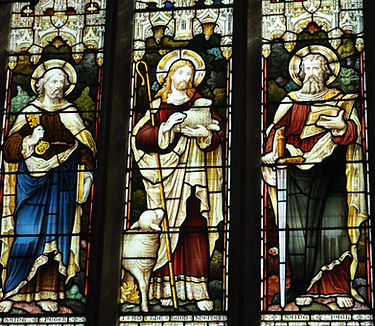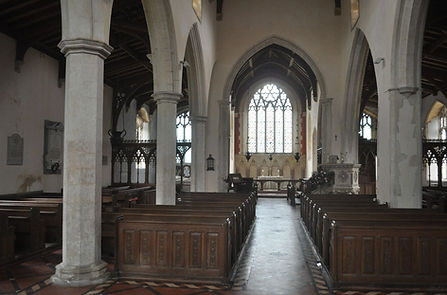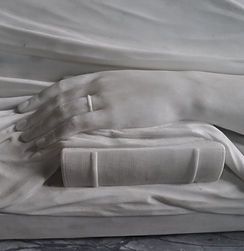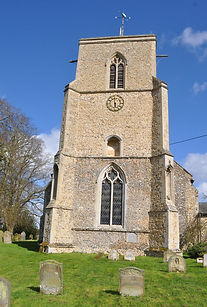TITTESHALL & HOLKHAM
Normally when I have included more than one church on a page on this site they have been linked together either because they are neighbouring villages or they have been picked as the highlights of a particular day’s churchcrawl. Here though I have bracketed the churches of St Mary at Tittleshall and St Withburga at Holkham together on the basis of their association with the Coke family.
Both villages can be found in Norfolk, with Holkham a coastal village with magnificent Holkham Hall, which is just to the West of Wells Next the Sea. Tittleshall is around 16 miles inland, just to the south of Fakenham; with the respective visits being four years apart.
Barrister Robert Coke purchased the manor of Tittleshall in the 1530’s when land was cheap after the Dissolution of the Monasteries; with the family home being at Mileham just to the south east of Tittleshall.
Robert Coke’s son Edward became Speaker of the House of Commons, Attorney General and Lord Chief Justice. In 1609 he purchased Neales manor in Holkham, the start of what was to be the Holkham Estate that we see today.
On visiting each of the churches here I was very taken with some superb monuments, with members of the Coke family being buried at Tittleshall until 1870 when the family mausoleum was built at Holkham. This page looks at each of these churches.
TITTLESHALL : CHURCH OF ST MARY
Church Post Code PE32 2RJ
Open to visitors
Visited April 2021
A gloriously sunny and warm April day in 2021; and a full days churchcrawling in Norfolk arriving at Tittleshall, and the church of St Mary, early in the afternoon. This was another church to be open and it was good to see a higher percentage of churches being open at this point as covid restriction eased for a time.
Tittleshall can be found some seven and a half miles south west of Fakenham and 11 miles to the north east of Swaffham, and recorded a population of 371 at the time of the 2021 census. The church of St Mary site to the east of the village; quiet and secluded, a place of peace in challenging times.
I stood to the south of the church taking in the exterior, a friendly black lab running across the field behind me. A couple trailed along behind. 'he won't hurt you' the lady shouted across to me. Safety hadn't even crossed my mind to be honest as the dog sprinted across the field towards me, sporting a joyous expression; half a yard tongue hanging out as he ran.
I spent a very pleasant few minutes with the couple who were rightly proud of their church and the fact that it was open again now, and had been where possible during the last few months. The pews were taped off and out of bounds, as was the sanctuary, but apart from that this there was freedom of movement within this glorious little church. The restrictions inside meant that I couldn't enter in to the sanctuary itself and therefore couldn't photograph the memorial to Edward Coke himself, who lays recumbent robed with impressive Elizabethan ruff, hands raised in prayer.
The church here dates mainly from the 14th century and is a basic structure of west tower, nave, south porch and chancel with mausoleum to the north. The substantial west tower is heavily buttressed with empty image niches part way up the buttress to north and south, which would have held statues prior to the reformation. There is also a more substantial empty nice to the west face of the tower; with the church clock facing out, also from the west.
There are no aisles or clerestories here, with the exterior plain, with no gargoyles or grotesques. The south porch is a bit battered with the top repaired in red brick. The nave and chancel each have a steeply pitched tile roof with the east end dominated by a substantial five light window. As with the porch the chancel is patched with red brick with the extension to the chancel to the north side also of red brick and dating from the 18th century.
The church was open to visitors with an automatic system which opened up the church at a given time daily. It was bright and welcoming inside, with plenty of windows along the south side of the nave negating the lack of a clerestory. Walls are whitewashed and an oak screen separates nave from chancel. A pleasing interior.





Stained glass here is of high quality with the five light east window depicting the risen Christ in majesty as central, enthroned and crowned, with hand raised in blessing; crucifixion wounds visible on hands and holing a book on which are the letters alpha and omega, the beginning and the end. He is flanked by the four Gospel writers, with their associated symbols appearing in small panels below. Up in the tracery, angels with brightly coloured wings hold banners praising God.
One other three light window has Jesus as the Good Shepherd central; flanked by Peter on our left, who holds the keys to the Kingdom of Heaven. To our right is St Paul, who as always is depicted with book open and sword pointed downwards, always perilously close to his sandalled foot. Peter is depicted with balding head but flowing hair at the back of his head. Paul is shown with a full head of hair which is not normally the case.


Against the north wall of the chancel is an alabaster memorial to Edward Coke’s first wife Briget. She passed away in 1598 in her mid 30’s and is depicted kneeling on a cushion; Bible resting on a desk in front of her. Her hands are both missing but would have been raised in prayer.
Below her, all facing to the east lined up behind a single prayer desk, are eight children; six boys and two girls. A little internet research suggests that they had ten children with two dying very young who are no included on the monument.
The boys are at the front with the two girls behind. The boys have hands raised in prayer; the girls hands are missing. I was drawn to the depiction of the older of the two girls in particular who I think was Anne. There is damage to her nose and her hands are missing but the quality of carving, especially the detail in her hair, is of the very highest quality.
Against the south wall of the chancel is a fine memorial to Jane Coke, wife of Thomas William Coke, 1st Earl of Leicester. Jane reclines against a column on which there a Bible. An angel reaches down to her, ready to escort her safely towards Heaven. A putto at the foot of the column holds a flaming heart. A wonderful piece of work, carved by Joseph Nollekens who was considered to be the finest British sculptor of the late 18th century.







There are no bells and whistles here, no worship band, no screens just a beautiful small village church steeped in history and character. An absolute jewel of a church; open and welcoming and which was a delight to visit.
The visit to Holkham, just over four years later, came about on a dull Sunday morning in September 2025. Holkham can be found some 16 miles to the north of Tittleshall, set a little inland from the coastline, alongside the busy A149 coast road. The population of the village was 218 at the time of the 2021 census.
There is plenty of history here with Holkham Camp a mile to the north west of the village being the site of an Iron Age fort. There is debate as to if this was the area where Iceni rebels were defeated by a Roman force in AD47; with Holkham Hall containing a collection of Roman statuary.
With regards the Coke family Edward Coke purchased Neales Manor in Holkham in 1609 but the Holkham Hall that we see today was built by Thomas Coke, 1st Earl of Leicester in the 18th century; with the house still in the hands of the same family today, with the 8th Earl being the current owner.
The present village is of more modern construction with the old village of Holkham being taken down and moved by the 1st Earl as Holkham Hall was being built. The hall was completed in 30 years with Thomas Coke passing away before it was completed, his wife Margaret completing this massive project.
HOLKHAM : CHURCH OF ST WITHBURGA
Church Post Code NR23 1RN
Open to visitors
Visited September 2025


We had started off the day with a brief visit to neighbouring Wells Next the Sea, with the church of St Withburga the first church of four visited on the way home. The church here is to be found just back from the main coast road, to the north west of the hall itself. There was a delightfully rural feel here; quiet and peaceful despite the busy coastal road not too far away; deer foraging close by.
The church here is dedicated to St Withburga; which is a unique dedication in this country. Withburga was a daughter of Anna who was king of the Angles. Withburga was born in 653AD and according to the informative church guide she spent her early life at Holkham. She went on to form a Benedictine nunnery at East Dereham of which she was the first abbess.
The visitor enters from the north east, with the church standing proud on a high mound composed of sand; with this either being man made in the Saxon period or a natural rise in the landscape, opinions differ. It is thought that there has been a church here since either Saxon times. Nothing remains of a Saxon church but foundations from that period were uncovered during excavations.



It appears that this early Saxon structure was replaced by a Norman church, which in turn was replaced by a church dating from the 13th century, with the base of the tower that we see today dating from that time. The church was in poor repair during the 18th century and was repaired in 1767 by Margaret Dowager Countess of Leicester, widow of the late Thomas Coke 1st Earl of Leicester who had built Holkham Hall.
The church was further extensively repaired in 1868 by Juliana Countess of Leicester, the widow of Thomas Coke, the 2nd Earl of Leicester.
This beautiful flintwork church consists of tower, which is offset to the south, nave with north and south aisles and clerestories, north and south chapels and chancel.
This is a church of great size; a real statement piece, with gravestones circling the church at a lower level almost reverentially. The substantial square tower is offset to the south and is heavily buttressed and battlemented, with intricate flushwork designs on both with coats of arms in between the battlements. Pinnacles at each corner are crocketed. Gargoyles peer out from each corner; I hope that they could see me better than I could see them on this dull Norfolk Sunday morning!
Looking at the church from the south, the tower occupies the area where the clerestory windows would have sat; just a single clerestory window visible on either side of the tower, a full four clerestory windows visible to the north.
A frieze runs the full length of the nave to north and south, with a flushwork design of a repeated trefoil shape throughout. A commanding exterior; as I stood there on a dull morning looking at the church from the east, I though how beautiful this scene would look with the sun setting in the west; the church silhouetted against the sunset.



The Sunday morning service had just finished as we arrived and it was good to chat with a few friendly locals who were just leaving. The church was remaining open and it was good to be able to look around. I had visited here once before, back in around 2008, with the church being closed on that occasion.
Moving inside, there are four bay arcades to north and south, with octagonal piers and capitals, with these dating from the late 14th century. The nave is separated from north and south chapels by oak screens. The hand of the Victorian restorers is very much in evidence throughout.
Moving in to the chancel the east window is of five lights and has patterned glass with repeated geometric shapes. The reredos is in the form of five blind arches; with the left hand arch containing the Lord’s Prayer; the central three lists the 10 Commandments and the right hand arch contains the creed. There is no piscina here but the sedilia, the seating for the priests during the Mass in pre reformation churches, is in the shape of a graduated window sill against the south wall of the chancel. The window itself is bricked in and there are three seats, with as always the seats rising in height to the east.





A monument in the south chapel features three couples kneeling at prayer desks facing each other, with hands raised in prayer.
Central we see John Coke with wife Merill Wheatley. The couple are flanked by Merill’s mother and father Anthony Wheatley and Anne Armiger and her grandparents William Wheatley and wife Martha Skinner.
Below we see John and Merill’s children, no fewer than 15 with six sons and nine daughters. They are all lined up with hands raised in prayer, with the sons first followed by the daughters. The sons have long flowing hair; the daughters wear head scarves that are tied under their chins. Interestingly not all of the children are looking straight in front of them as would normally be the case. Some have their heads turned, looking directly at the onlooker. Curious!
Close by on the north wall we see Merill’s uncle Miles Armiger kneeling before a prayer desk, wearing long flowing robs and sporting a fine Elizabethan ruff; with human skull alongside. Sadly on the day the light coming in through the south window alongside affected my photograph so there is no visual of this one.





Resting serene in the north chapel is a beautiful memorial to Juliana Countess of Leicester, who had financed the late 1860’s restoration of this church. This was carved by Sir Joseph Boehm, whose work can be seen in Windsor Castle, the Victoria and Albert Museum, Westminster Abbey and Canterbury Cathedral and a little further away a carving of Queen Victoria which can be seen in Sydney Australia.
The inscription below reads ‘Juliana… by whose pious care this church was restored and re-opened Dec 14th 1869’.
In a work of breathtaking quality she lays as if asleep, with a real flower placed in her hand; eyes closed and with long flowing hair. Her left hand wears a wedding ring and is placed on a Bible. Indentations made recently by her are somehow carved in to her pillow. Possibly the most beautiful monument that I have seen on my travels!





A ledger slab depicts a carving of a human skull with crossed bones below; these being symbols of mortality used to remind the onlooker that Man is mortal and will die. So live a good life, trust in God and do not be caught lacking when your own time comes. And in those days of low life expectancy it might be later than you think!



We have looked at two churches on this page; one being a small village church; humble in stature with the other being grander; a real statement piece. Each is rich in history and each are generally open to visitors and are well worth taking a look at if you are in this area of Norfolk.
We headed west, through the Burnhams; stopping off at the church of St Margaret at Burnham Norton, along with Hales, my favourite round tower churches in the county. The intention was then to have lunch in Hunstanton before heading back towards Kings Lynn. This was scuppered due to a total lack of parking spaces in Hunstanton; which did not bode well for those in the two miles or so stream of traffic heading towards ‘Sunny Hunny.




